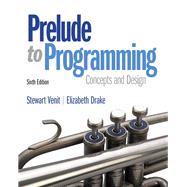Prelude to Programming is appropriate for Pre-Programming and Introductory Programming courses in community colleges, 4-year colleges, and universities. No prior computer or programming experience is necessary although readers are expected to be familiar with college entry-level mathematics.
Prelude to Programming provides beginning students with a language-independent framework for learning core programming concepts and effective design techniques. This approach gives students the foundation they need to understand the logic behind program design and to establish effective programming skills.
The Sixth Edition offers students a lively and accessible presentation as they learn core programming concepts — including data types, control structures, data files and arrays, and program design techniques such as top-down modular design and proper program documentation and style. Problem-solving skills are developed when students learn how to use basic programming tools and algorithms, which include data validation, defensive programming, calculating sums and averages, and searching and sorting lists.
Teaching and Learning Experience
This program presents a better teaching and learning experience–for you and your students. It provides:
- A Language-Independent, Flexible Presentation: The text has been designed so that instructors can use it for students at various levels.
- Features that Help Solidify Concepts: Examples, exercises, and programming challenges help students understand how concepts in the text apply to real-life programs.
- Real Programming Experience with RAPTOR: Students gain first-hand programming experience through the optional use of RAPTOR, a free flowchart-based programming environment.
- Support Learning: Resources are available to expand on the topics presented in the text.









